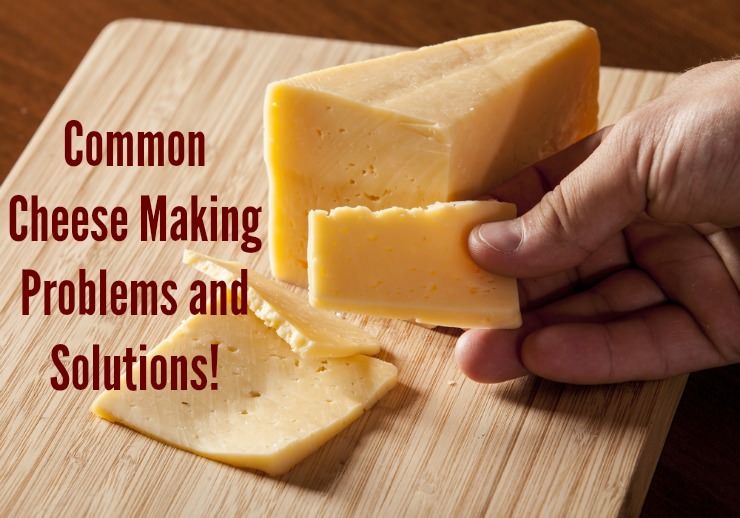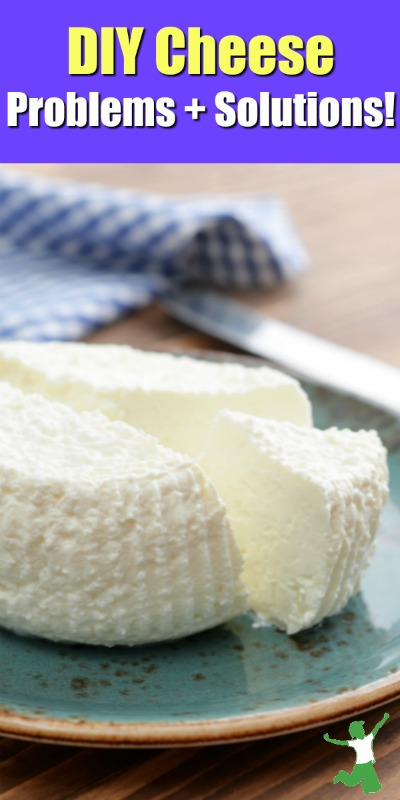Table of Contents[Hide][Show]
- Cheese Making Can Be Easy!
Most Common Cheese Making Problems and Solutions+−
- Wet Spots on the Cheese
- Holes in the Cheese
- Cheese Tastes Sour
- Curds Do Not Form During the Cheese Making Process
- Mold Grows on the Surface of the Cheese or Under the Wax
- Cheese is Oily While Aging
- Cheese is Rubbery
- Cheese Tastes Bitter
- Cheese is Too Dry
- Cheesecloth is Difficult to Remove and Tears the Cheese
- Cheese has the Texture of a Sponge, Oozes and Smells
- Cheese Lacks Flavor
- Milk Won’t Coagulate

The artisanal craft of cheese making in the home environment has gathered a significant amount of momentum in recent years. This trend is due in part due to renewed interest in fermented, probiotic-rich, ancestral foods. Healthy cheese itself is one of the most ancient of foods with the practice of cheese making predating all recorded history. Interestingly, cheese is also the most stolen item in the world!
Other people taking up the hobby of cheese making have become disillusioned with the chemical-ridden processed cheese options at the store along with misleading cheese labels which contribute greatly to the frustration. For example, some store cheeses are allowed by the FDA to be labeled as “raw“, when they are anything but!
Combine this with the high price of quality cheese at gourmet shops or cheese blocks shipped in directly from dairy farms, and the time required to learn cheese making seems well worth the effort.
The great news is that cheese making is a very straightforward process – simpler than you might think – particularly with the softer cheeses like ricotta, gjetost, or cream cheese just to name a few.
Cheese Making Can Be Easy!
Some of the most frequent emails I receive are from readers delving into cheese-making for the first time: the raw milk won’t coagulate or the cheese has mold or smells funny and so on. While it can be very difficult to troubleshoot these problems from afar, now there is a straightforward handbook, Cheese Making Made Easy, that provides the how-to, supply suggestions, recipes, and troubleshooting you need to launch your home cheese making operation with minimal headaches.
This excellent and helpful book is written by Dina-Marie Oswald, of My Cultured Palate.
Dina-Marie has given me permission to reprint an excerpt pertaining to common DIY cheese problems and solutions for you to check out.
If making cheese at home is your thing or something you want to try, be sure to save yourself more than a few trials and tribulations and probably a lot of money down the drain with failed attempts.
Most Common Cheese Making Problems and Solutions
Wet Spots on the Cheese
Too much moisture. Turn the cheese more frequently and be careful to cook the curds according to the instructions.
Holes in the Cheese
Contamination is probably the cause–be careful to keep hands and utensils clean–make sure milk is not contaminated – coliform bacteria can grow and cause holes to form in cheese. If this is the cause, you will smell a yeasty smell as the curds cook.
Another cause could be the cheese-making starter was too acidic or you may have added too much starter. You may also have allowed it to ripen too long after adding the starter culture. Another reason could be leaving the curds in the whey too long after cooking which raises the acidity level.
Cheese Tastes Sour
The cheese has too much moisture–next time reduce the moisture by cooking the curds slower to expel more whey from them.
Curds Do Not Form During the Cheese Making Process
This can be due to several things:
- Using old rennet or not enough rennet (vetted source).
- If the milk used for cheese making contains even a small amount of liquid colostrum, it will not coagulate.
- If the temperature is too low, the milk will not coagulate – check your thermometer for accuracy.
- Dissolving the rennet in water that is too warm will destroy the enzymes that cause the milk to coagulate.
Mold Grows on the Surface of the Cheese or Under the Wax
Check the temperature at which you are storing the cheese–it may be too warm or too moist. Lower the aging temperature.
Cheese is Oily While Aging
- Cheese is stored at too warm a temperature and the fat oozing out is causing the oiliness – lower the aging temperature.
- The curds were stirred too hard or overheated.
Cheese is Rubbery
Overheating or adding too much rennet or both could be the culprit for this common cheese-making problem.
Cheese Tastes Bitter
- May be caused by storing the milk too warm before making the cheese.
- Contaminated cheese making equipment.
- Too much acidity in the cheese-making process.
- Using too much rennet.
- Not enough salt.
Cheese is Too Dry
- Not enough rennet was used.
- Curds were cut too small.
- Not treating the curds gently and overworking them.
- Not enough humidity during aging – use a bowl of water to add humidity.
Cheesecloth is Difficult to Remove and Tears the Cheese
May indicate yeast or bacterial growth due to contamination making the cheese swell- be aware of cleanliness and possible sources of contamination.
Cheese has the Texture of a Sponge, Oozes and Smells
This problem indicates yeast contamination and not keeping equipment clean during the cheese-making process. Be sure to cover the cheese during the drying process to keep flies off.
Cheese Lacks Flavor
- Allow the cheese to age longer.
- The cheese may not contain enough acid – increase the acidity by allowing it to ripen for the correct amount of time and watch the temperature and be sure to add enough starter culture.
Milk Won’t Coagulate
- The milk is too cool or too warm – check your thermometer for accuracy.
- Rennet is too old. Rennet tablets should be stored in the freezer for up to 3 years. Liquid rennet should be stored in the refrigerator for up to 1 year. If you started a batch of cheese and the milk will not coagulate, add more rennet. If the rennet is weak, be sure to add more than the recipe calls for. This is a vetted, quality rennet source.
Isn’t this fantastic information? I’ve been making cheese for years and didn’t even realize some of this!

More Information
Gouda Cheese: Nutrient Dense Cheese of Choice
Perfect Probiotic Cottage Cheese
Homemade Quark Cheese
Why I Gorged on Brie Cheese When I Was Pregnant
Cheese: The Most Stolen Item in the World
How to Make Yogurt Cheese (raw or pasteurized)
Drowning in Whey? Make Gjetost Cheese.
Video: Cream Cheese and Liquid Whey.
Three Ways to Make Ricotta Cheese (plus video how-to)








I’ve started making mozzarella with citric acid and liquid rennet. The first 3 batches turned out great, now the last 2 batches I made formed a weak curd, even after adding more rennet, so after a half hr I went ahead and cut it anyway. It ended up being very easily stretched and floppy. The last time I made it I used 1 and a half teaspoons rennet. Seems the more I use it doesn’t make a difference with the end result.
My 8 months aged gouda is “hot” like hot peppers, not bitter. It tastes good,texture is good, but a quite hot aftertaste. This only happens with longer aging, more than 2 months. What would be the cause? It also has happened with aged Colby and brie.
Very helpful. My cheddar was always a bit dry. Not any more. Bit more rennet and bowl of water solved the problem
this was very helpful. my water was too hot for the rennet.
Sarah, I haven’t quite gotten around to cheesemaking yet, but I’m bookmarking this for the day when I can finally give my attention to it.
I was quite interested in this – I would have liked to have seen reviews from people who had used the recipes to make a hard cheese – I make kefir and drip it for soft cheese and for me the major difference is in the type of milk used (for instance goat milk and full-fat cow milk make very different products) – I’d like to make hard cheese, but I’m not sure (from seeing the chapter titles) that this will have enough information to justify the price ($10.99). I’d love to see reviews/success stories from users.
Hey this is a terrific reference article! Thank you ! I haven’t quite geared up for cheese making, but it is on my to do list and I have this bookmarked.